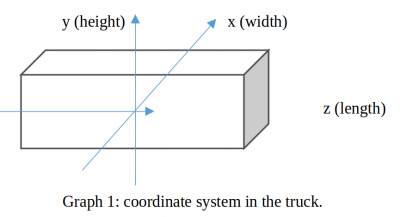HuaweiVRP
Материал из DISCOPAL
Input JSON format
- estimateCode
- String → Identification of the input file.
- algorithmBaseParamDto
- Object → Basic data
- platformDtoList
- Array → Platform (i.e., pick-up point) info.
- platformCode
- String → Identification of the platform.
- mustFirst
- Boolean → Whether the platform should be first visited (bonded warehouse).
- truckTypeDtoList
- Array → Truck info.
- truckTypeId
- String → Identification of the truck.
- truckTypeCode
- String → Unique truck code.
- truckTypeName
- String → Unique truck name.
- length
- Float → Truck length (mm).
- width
- Float → Truck width (mm).
- height
- Float → Truck height (mm).
- maxLoad
- Float → Carrying capacity of the truck (kg)
- truckTypeMap
- Object → Map format of truckTypeDtoList, key is truckTypeId
- distanceMap
- Object →
- Key is two platform codes connected by “+”: e.g. “platform01+platform02”;
- Value is the float value of the distance (m) between them.
- boxes
- Array → Boxes (i.e., items) info.
- spuBoxId
- String → Identification of the box.
- platformCode
- String → Code of the platform the box is belonging to.
- length
- Float → Box length (mm).
- width
- Float → Box width (mm).
- height
- Float → Box height (mm).
- weight
- Float → Box weight (kg).
Output JSON format
- estimateCode
- String → Identification of the output file. Same as the input file.
- solutionArray
- 2D-Array → Array of solutions. Each line is a solution, i.e. an array of trucks. Each element is a truck map.
- truckTypeId
- String → Identification of the truck. Same as the input file.
- truckTypeCode
- String → Truck code. Same as the input file.
- piece
- Integer → Number of boxes packed in this truck.
- volume
- Float → Total volume (mm^3) of boxes packed in this truck.
- weight
- Float → Total weight (kg) of the boxes packed in this truck.
- innerLength
- Float → Truck length (mm). Same as the input file.
- innerWidth
- Float → Truck width (mm). Same as the input file.
- innerHeight
- Float → Truck height (mm). Same as the input file.
- maxLoad
- Float → Carrying capacity of the truck (kg). Same as the input file.
- platformArray
- Array → Route of the truck, a list of platform codes.
- spuArray
- Array → Array of boxes packed in this truck.
- spuId
- String → Identification of the box. Same as the input file.
- platformCode
- String → Code of the platform the box is belonging to. Same as the input file.
- direction
- Integer → Direction of the box (100: box length is parallel to the truck length; 200: box length is perpendicular to the truck length).
- x
- Float → Coordinate of the center of the box (mm) in direction of the truck width, where the origin is the center of the truck.
- y
- Float → Coordinate of the center of the box (mm) in direction of the truck height, where the origin is the center of the truck.
- z
- Float → Coordinate of the center of the box (mm) in direction of the truck length, where the origin is the center of the truck.
- order
- Integer → Order of the box being packed.
- length
- Float → Box length (mm). Same as the input file.
- width
- Float → Box width (mm). Same as the input file.
- height
- Float → Box height (mm). Same as the input file.
- weight
- Float → Box weight (mm). Same as the input file.
Coordinate System
The coordinates of the center of the boxes are represented in the output files, where the origin coordinate system is the center of the truck, shown in the following graph 1.
The boxes can only be rotated horizontally, thus each of them only have 2 possible directions represented in the output files (100: box length is parallel to the truck length; 200: box length is perpendicular to the truck length), shown in the following graph 2.

[ Хронологический вид ]Комментарии
Войдите, чтобы комментировать.